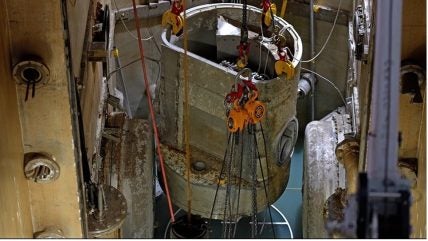
A team from Oak Ridge Office of Environmental Management (OREM) contractor UCOR have lifted and removed the lower reactor vessel from the Oak Ridge Research Reactor, also known as Building 3042. The US Department of Energy (DOE) Office of Environmental Management said the accomplishment was a major development for one of the largest deactivation projects at Oak Ridge National Laboratory (ORNL). Removing the vessel is the first step before preparing the remainder of the facility for demolition.
Workers used a 72-inch diamond wire saw to cut the final pieces that held the lower reactor vessel in place at the bottom of the reactor pool. They used a 20-tonne overhead crane to lift that equipment and load it into a 32,000-pound protective cask to ship it for disposal offsite.
“Removing the reactor vessel from the Oak Ridge Research Reactor facility has been an incredibly complex task,” said Jim Daffron, ORNL Portfolio Project Director. “Through an immense amount of planning and careful execution, workers were successful and completed the work safely.”
UCOR took out the top portion of the reactor vessel in autumn 2023. Since then, crews have focused on filtering and draining the reactor pool water to reach irradiated materials and prepare for the lower reactor vessel removal.
Rigorous safety measures were in place due to high radiation dose rates, and those rates increased as thousands of gallons of pool water were pumped into tanks outside the facility, lowering the buffer between the radioactive materials and workers. With the wastewater safely drained, employees performed sampling and characterising to ensure the work areas remained safe for final tasks, including removal of components.
“We faced various challenges throughout the pool reactor remediation and clean-up process with our key partner, Energy Solutions, who provided their knowledge and expertise in collaboration, helping us resolve critical issues quickly and safely,” said Steven Reed, UCOR Oak Ridge Research Reactor project manager.
Workers removed 127,000 gallons of water and sediment to reach the lower portion of the reactor vessel, which sat on the pool floor. They also took out the lead brick shielding in the basement that surrounded the pool. Some 20 crew members loaded 157,000 contaminated bricks into containers.
The next steps involved in preparing for demolition will involve isolating and deactivating 6,000 feet of piping. Crews will also finish draining the pool water and encapsulating the 25-foot-deep pool with a fixative to reduce contamination migration during demolition.






